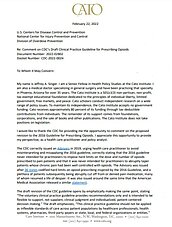To Whom it May Concern:
My name is Jeffrey A. Singer. I am a Senior Fellow in Health Policy Studies at the Cato Institute. I am also a medical doctor specializing in general surgery and have been practicing that specialty in Phoenix, Arizona for over 35 years. The Cato Institute is a 501(c)(3) non-partisan, non-profit, tax-exempt educational foundation dedicated to the principles of individual liberty, limited government, free markets, and peace. Cato scholars conduct independent research on a wide range of policy issues. To maintain its independence, the Cato Institute accepts no government funding. Cato receives approximately 80 percent of its funding through tax-deductible contributions from individuals. The remainder of its support comes from foundations, corporations, and the sale of books and other publications. The Cato Institute does not take positions on legislation.
I would like to thank the CDC for providing me the opportunity to comment on the proposed revision to the 2016 Guideline for Prescribing Opioids. I appreciate this opportunity to provide my perspective, as a health care practitioner and policy analyst.
The CDC correctly issued an Advisory in 2019, urging health care practitioner to avoid misinterpreting and misapplying the 2016 guideline, correctly stating that the 2016 guideline never intended for practitioners to impose hard limits on the dose and number of opioids prescribed to pain patients and that it was never intended for practitioners to abruptly taper patients whose chronic pain had been well controlled with opioids. The Advisory was issued after 36 states codified hard limits on opioid prescribing inspired by the 2016 Guideline, and a plethora of patients subsequently being abruptly cut off from or denied pain medication, many of whom resumed a life of despair. It was also issued around the same time that the American Medical Association released a similar statement.
The draft revision of the CDC guideline opens by emphatically making the same point, stating “The voluntary clinical practice guideline provides recommendations only and is intended to be flexible to support, not supplant, clinical judgment and individualized, patient-centered decision-making.” The draft emphasizes, “This clinical practice guideline should not be applied as inflexible standards of care across patient populations by healthcare professionals, health systems, pharmacies, third-party payers or state, local, and federal organizations or entities.”

This work is licensed under a Creative Commons Attribution-NonCommercial-ShareAlike 4.0 International License.

